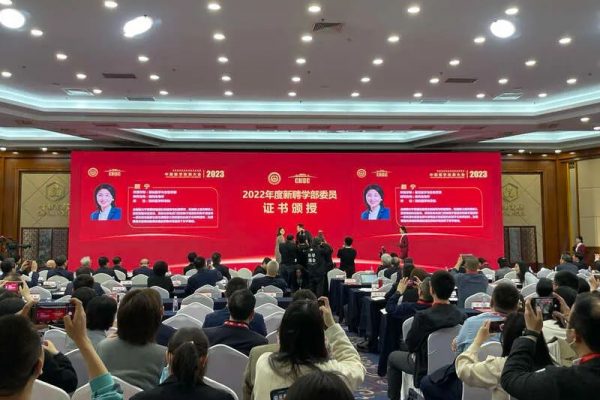Chip发表复旦大学朱颢团队最新成果:高稳定性MoS₂光电探测器单元及其在传感器内计算应用
FUTURE远见| 2022-09-26
Future|远见
Future|远见future选编
人工智能和物联网的发展使得系统的感知节点快速增加,并产生持续增长的未结构化的原始数据。在传统的系统设计中,感知的模拟信号通过模数转换单元转换成数字信号,然后传输到其它的计算单元里进行计算任务。这种将传感端和计算处理单元分开的架构会导致相对较高的功耗、数据获取延迟以及硬件冗余等。为应对传感计算分离架构的诸多缺点,可以缩短数据处理时间、降低功耗和提高器件面积的先进传感器内计算(In-sensor computing)架构被提出。此种新架构对实现在延迟方面要求苛刻的、传感器丰富的平台或应用(比如自动驾驶、微型机器人和实时视频分析等)具有重要意义²。
二维过渡金属硫族化合物(TMDs)具有新奇的电学和光学性质。基于二维TMDs的光电探测器也在图像传感器、光伏、人工视觉电子和神经突触等方面表现出具有前景的应用。在多种二维TMD材料中,二硫化钼(MoS₂)由于其独特的结构和性质,如带隙可调、原子级的厚度和无悬挂键等,吸引了广泛的研究兴趣。最近,基于表面饱和反应机制的原子层沉积(ALD)制备晶圆级连续TMD薄膜的工艺被提出。由ALD制备的TMD薄膜具有多方面的优点,比如精确的材料厚度控制,优异的均匀性、同质性以及台阶覆盖特性³⁻⁵,为大规模、多功能的电路级集成应用提供了新的解决途径。
本研究采用ALD制备了晶圆级的二维MoS₂薄膜,并基于大面积的MoS₂薄膜制备了传感器内计算的光电单元。该MoS₂光电探测器单元采用顶栅器件结构,并使用在透明和柔性电子器件中广泛使用的透明电极氧化铟锡(ITO)作为顶栅电极。本研究所制备的顶栅MoS₂探测器单元与背栅结构的探测器单元相比具有更好的空气稳定性。此MoS₂光电探测器单元在光波长(λ)为500 nm,光功率密度(Pᵢₙ)为16.0 μW cm⁻²时,具有最大的光电响应度(R = 555.8 A W⁻¹)。另外,基于MoS₂光电探测器单元,本研究也构建了具有均匀性和良好的光电响应特性的器件阵列。
该研究还基于MoS₂光电探测器单元成功地构建了多功能的逻辑门,包括非门/反相器(Inverter),与非门(NAND),或非门(NOR)。这些多功能和强健的传感器内计算功能的实现,主要得益于基于ALD制备的晶圆级均匀MoS₂薄膜以及特殊的器件结构设计。由于光信号探测与逻辑功能的一体化是基于MoS₂光电探测器单元实现的,本工作制备的大面积MoS₂薄膜优化了功能器件总面积。本工作为高性能集成感知和数据处理系统在多领域的应用的实现提供了新方案。
Sensitive MoS₂ photodetector cell with high air-stability for multifunctional in-sensor computing¹
The development of artificial intelligence (AI) and the Internet of Things (IoT) has induced rapid growth of sensory nodes, which generates an ever-increasing volume of unstructured and raw data. In systems based on conventional designs, analog sensory data are initially transformed into digital data by analog-to-digital conversion, and then transferred to other computing units for performing computation tasks. The architecture of separation of sensory terminals and computing units will lead to relatively high power consumption, data-access delay, and hardware redundancy². Alternatively, advanced technology of in-sensor computing has been proposed to improve time, energy, and area efficiency, which is of substantial importance for implementing sensor-rich platforms and applications with strict delay requirements, such as autonomous driving, microrobots, and real-time video analysis. Recently, photoelectronic devices based on two-dimensional (2D) transition metal dichalcogenides (TMDCs) have been widely studied because of their fascinating electrical and optical properties, and have shown potential applications in image sensors, photovoltaics, artificial visual electronics, and neuromorphic synapses, and so forth. Specially, as one of the fundamental perceptions of humans, vision is responsible for more than 80% of all the information intake. Light sensing and the corresponding data processing involving novel materials-based devices is of great importance in artificial intelligence applications.
Among the various 2D TMDCs, molybdenum disulfide (MoS₂) has attracted tremendous research interest because of its unique structure and properties, such as tunable bandgap, atomic thickness, and lack of dangling bonds. To date, most MoS₂ photoelectronic devices are based on MoS₂ flakes with sizes of dozens of microns prepared by mechanical exfoliation or chemical vapor deposition, which hinders their large-scale integration applications. The synthesis of uniform, wafer-scale 2D TMDC thin films is a key step towards their subsequent integration into micro/nano devices and circuits. Recently, atomic layer deposition (ALD) based on the surface saturation reaction has provided a promising approach to preparing wafer-scale continuous TMDC thin films³⁻⁵. The synthesized film has the advantages of precise thickness controllability, excellent uniformity, homogeneity, and step coverage, which will facilitate large-scale and multifunctional circuit-level integration applications.
In-sensor computing schemes integrating sensing and processing have provided a promising route to address the sensing/processing bottleneck by reducing power consumption, time delay and hardware redundancy. In this study, an in-sensor computing architecture involving a photoelectronic cell based on a wafer-scale two-dimensional MoS₂ thin film was demonstrated. The MoS₂ photodetector cell used a top-gate device structure with indium tin oxide (ITO) as the transparent gate electrode, which exhibited high air-stability and a high photoresponsivity (R) of up to 555.8 A W⁻¹ at an illumination power density (Pᵢₙ) of 16.0 μW cm⁻² (λ=500 nm). Additionally, a MoS₂ photodetector array with uniform photoresponsive characteristics was achieved. Furthermore, logic gates, including an inverter, NAND, and NOR, were achieved based on MoS₂ photodetector cells. Such multifunctional and robust in-sensor computing was ascribed to the uniform wafer-scale MoS₂ film grown by ALD and unique device structure. Because the detection of optical signals and logic operations were achieved based on MoS₂ photodetector cells with area efficiency, the proposed in-sensor computing device paves the way for potential applications in high-performance, integrated sensing and processing systems.
参考文献
[1]Zhao, D.-H. et al. Sensitive MoS₂ photodetector cell with high air-stability for multifunctional in-sensor computing. Chip 1, 100023 (2022).
[2]Zhou, F. & Chai, Y. Near-sensor and in-sensor computing. Nat. Electron. 3, 664-671 (2020).
[3]Zhao, D.-H. et al. Large-scale multilayer MoS₂ nanosheets grown by atomic layer deposition for sensitive photodetectors. ACS Appl. Nano Mater. 5, 10431 (2022).
[4]Zhao, D.-H. et al. Band alignment of atomic layer deposited MoS₂/(HfO₂)x(Al₂O₃)1−x heterojunctions for device applications. J. Phys. D: Appl. Phys. 55, 225102 (2022).
[5]Zhao, D.-H. et al. Realizing an omega-shaped gate MoS₂ field-effect transistor based on a SiO₂/MoS₂ core–shell heterostructure. ACS Appl. Mater. & Interfaces 12, 14308 (2020).
论文链接:
https://www.sciencedirect.com/science/article/pii/S2709472322000211
关于Chip
Chip是全球唯一聚焦芯片类研究的综合性国际期刊,已入选由中国科协、教育部、科技部、中科院等单位联合实施的「中国科技期刊卓越行动计划高起点新刊项目」,为科技部鼓励发表「三类高质量论文」期刊之一。
Chip期刊由上海交通大学与Elsevier集团合作出版,并与多家国内外知名学术组织展开合作,为学术会议提供高质量交流平台。
Chip秉承创刊理念: All About Chip,聚焦芯片,兼容并包,旨在发表与芯片相关的各科研领域尖端突破性成果,助力未来芯片科技发展。迄今为止,Chip已在其编委会汇集了来自13个国家的68名世界知名专家学者,其中包括多名中外院士及IEEE、ACM、Optica等知名国际学会终身会士(Fellow)。
Chip第三期将于2022年9月在爱思唯尔Chip官网以金色开放获取形式(Gold Open Access)发布,欢迎访问阅读文章。
爱思唯尔Chip官网:
https://www.journals.elsevier.com/chip
Warning: Invalid argument supplied for foreach() in /www/wwwroot/www.futureyuanjian.com/wp-content/themes/future/single-news.php on line 41



